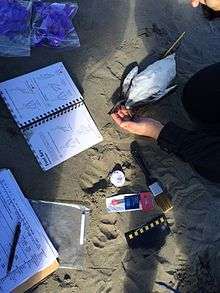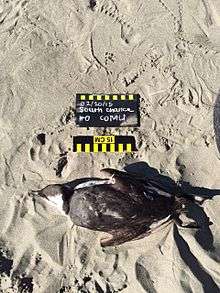COASST
COASST (Coastal Observation and Seabird Survey Team) is a citizen science project of the University of Washington, Seattle, WA, USA, with a vision of monitoring marine ecosystem health with the support of citizens within coastal communities.[1] With the help of hundreds of volunteers from different locations spanning the entire U.S. west coast from Washington to California and into the northern state of Alaska, COASST assesses beach conditions and identifies and tracks any carcasses of dead seabirds found. Data on the carcass of a seabird contributes to creation of a baseline record for the death rates of various species of seabirds including which beaches birds are found at and in what density. Any irregularities can be identified and evaluated so the cause of any increased mortality can be identified. COASST believes citizen scientists partnered with trained scientists create an invaluable relationship that benefits our ability to track and understand marine ecosystems. COASST works closely with state, tribal and federal agencies, environmental organizations and community groups to help this vision of monitoring, and successfully establish marine conservation solutions.

History

COASST was founded in 1998 by Dr. Julia Parrish after her long-time work with coastal seabirds of the Pacific Northwest.[2] Dr. Parish yearned for a change in the limitations of academic and agency science programs and wanted to be able to collect detailed annual data on seabirds. Dr. Parrish decided that there was a need for a seabird monitoring program that could generate baseline data for discovering patterns of seabird mortality, natural or human-induced, through the program. Due to the increasing human use of coastal waters, Dr. Parish envisioned a program that could provide data on both resident and migrant species of birds; mortality rates after oil spills; levels of chronic oiling, information regarding incidents of entanglement with fishing gear; and causes of death for seabird populations. After deciding that live bird monitoring programs were more difficult, Dr. Parish decided that an efficient, and more tractable program, could monitor carcasses from beached birds. The dead seabirds could be tracked and identified by anyone.
In July 1998, Dr. Parrish obtained a grant from the David and Lucile Packard Foundation to fund her vision of creating a seabird monitoring program that would generate baseline data to help assess patterns of seabird mortality due to natural and human-induced events. The first director of the program Dr. Todd Hass co-developed COASST with Dr. Parrish. Ten years later, COASST has expanded from monitoring five beaches along the outer coast of Washington state, to almost 300 beaches spread across northern California, Oregon, Washington, and Alaska. COASST now has 500 participants, which makes COASST the largest beached bird monitoring network in the world today.
Current events
Currently, COASST is working hard to understand the cause of a crisis with Cassin's Auklet and the thousands of dead carcasses that have been found.[3] News, events, and other information related to COASST can be found on their blog
References
- "What's COASST?". COASST.
- "History". COASST.
- Welch, Craig. "Mass Death of Seabirds in Western U.S. is 'Unprecedented'". news.nationalgeographic.com. National Geographic. Retrieved 22 March 2015.